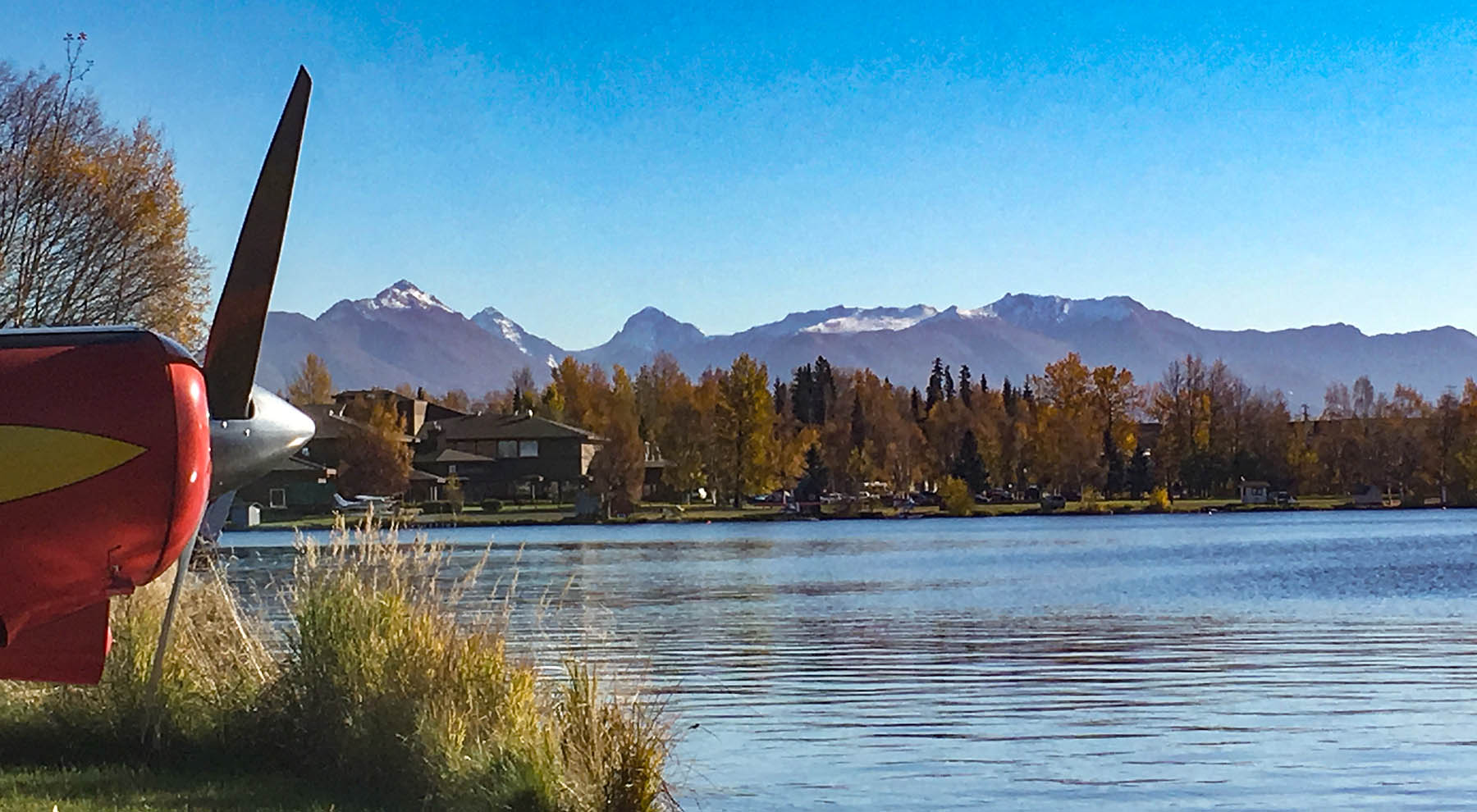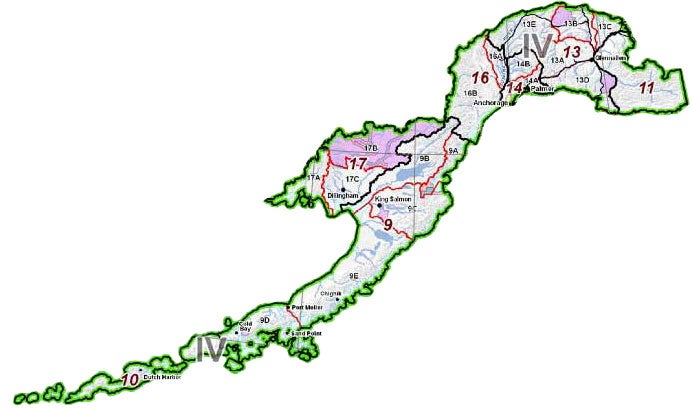Region 4 East: Interior, Anchorage and the Susitna Valley
Region 4 (east) begins at the Canadian border north of Valdez and continues westward through the Anchorage area, along Cook Inlet to the western border of GMU 16, along the Western Alaska Range. The area offers excellent opportunities for climbers in Denali National Park, the Chugach Mountains, and the Wrangell- St. Elias areas. Fishing and hunting opportunities are seemingly endless, as are hiking, mountain biking, camping (both on and off the road system). Winter sports such as ice fishing, cross-country skiing, downhill skiing and snowmachining are popular winter sports here, with numerous road-based and remote options. Region 4 (east) has three downhill ski areas, all accessible by road from Anchorage; Hilltop, Arctic Valley, and Alyeska.

The Road System
When it comes to access, Region 4 is a place of sharp contrasts. The eastern end is the most heavily roaded area in Alaska, but when you go west of Anchorage, roads disappear and you are limited to aircraft access almost exclusively. Let's look at the road system in this area.
The Denali Highway
A dirt track that is frequently closed in winter, the Denali Highway begins at the Parks Highway near Cantwell (on the fringes of Denali National Park), and continues east to the small town of Paxson, near the Gulkana River. The Denali Highway is a popular access corridor for hunters and fishermen, campers, and hikers, however it is very rustic and few amenities are available (including fuel) along the way. A nice exception is the lodge located at the MacLaren River crossing, where fuel, meals, and lodging are available.
The Glenn Highway
Beginning in Palmer and pointing east to its terminus with the Alaska Highway at Tok, the Glenn winds through Chickaloon, Sutton, Eureka, Glennallen and Gakona before coming to the small town of Tok. The road offers excellent access to the Matanuska River and other locations from which you can charter aircraft, unload a snowmachine, or put a boat in the water to experience recreational opportunities in the Chugach Mountains, the Talkeetna Mountains, or the Nelchina basin.
The Parks Highway
Originating in Anchorage, the George Parks Highway is the primary route north to Denali National Park, and Fairbanks. The drive to Fairbanks takes about 6.5 hours or so, depending on conditions, and it runs through some very remote country where few or no services are available. The Alaska Railroad roughly parallels the Parks for most of the way to Fairbanks, and actually crosses the highway in a few places.
The Seward Highway
The Seward Highway is, by far, the most well-traveled highway in the summer months. Linking Anchorage to the Kenai Peninsula, it is the primary access corridor for travelers accessing the port towns of Whittier, Seward, Soldotna and Homer.
Public-Use Cabins
Region 4 (east) contains many cabins that are available for use by the general public. Most require advance reservations and user fees are usually charged by the night. Amenities are spartan; expect to find an outhouse, bunks with no bedding or mattresses, no food, no dishes or cookstove, and no power or running water. Most have wood-fired or oil-fired stoves for heat. See our Public-Use Cabins page for locations, recommended gear, reservation and contact information.
Boating in Region 4 East
Region 4 (east) offers whitewater rafting, lake boating, float hunting and float fishing both on and off the road system.
Saltwater
The Port of Anchorage offers recreational boat launch facilities and a host of other amenities of interest to saltwater boaters, however saltwater fishing opportunities are extremely limited in the silty, shallow, muddy waters of lower Cook Inlet.
Freshwater
The Port of Anchorage is a common jump-off point for boaters intending to access the lower Susitna or any of several tributaries to the Susitna system, namely the Yentna Rivr, Alexander Creek, Deshka River and Lake Creek.
Bremner River| Chitna River | Little Susitna River| Talachulitna River
Fishing in Region 4
Region 4 contains a generous population of lake trout, Dolly Varden, grayling, northern pike, and all five species of Pacific salmon. But because much of it is on the road system, some fisheries can become crowded in the summer months. Read through our fishing forums for details on the numerous opportunities.
Anchorage | Northern Cook Inlet
Hunting in Region 4
 Region 4 (east) contains GMUs 11, 13, 14(A, 14(B) & 16.
Region 4 (east) contains GMUs 11, 13, 14(A, 14(B) & 16.
Southcentral Alaska offers inexpensive, trail-accessible hunting opportunities for moose, caribou, Dall sheep, brown/grizzly bear, black bear, Rocky Mountain goat and wolf. Limited waterfowl hunting exists in this area, as does upland game bird hunting for grouse and ptarmigan
Species Information
Want to learn how to hunt the species that inhabit Region 4 (east)? Visit our species pages, which provide information on species biology, distribution, and how to hunt the various species available in this region. A complete resource list on each species is also provided.
Bison | Black Bear | Brown Bear | Caribou | Goat | Moose | Sitka black-tailed deer | Wolf
IMPORTANT NOTICE FOR HUNTERS IN SOUTHCENTRAL ALASKA: If you have wounded an animal in the Anchorage / Portage / Mat-Su Valley area, and need help finding it, contact Alaska Game Search. They use blood tracking dogs to locate wounded game. Their two primary purposes are 1) to reduce the suffering of animals wounded by hunters and 2) to reduce the risks to the public, from wounded game animals. They work closely with the Alaska Department of Fish and Game, and the Alaska State Troopers and receive most of their referrals from these organizations. They also take direct referrals from the public, and the service is free. You can contact them AT THIS LINK.
ADF&G Contact Information for Southcentral Alaska
ADF&G Management and Harvest Reports, a vital hunt-planning tool, can be found AT THIS LINK. Reports are listed in sequential order by species. For detailed research into population trends, review several reports. For more recent data contact the area biologist. The biologists for Region 4 are located in the office in Palmer. The phone number there is 1 (907) 746-6300.
